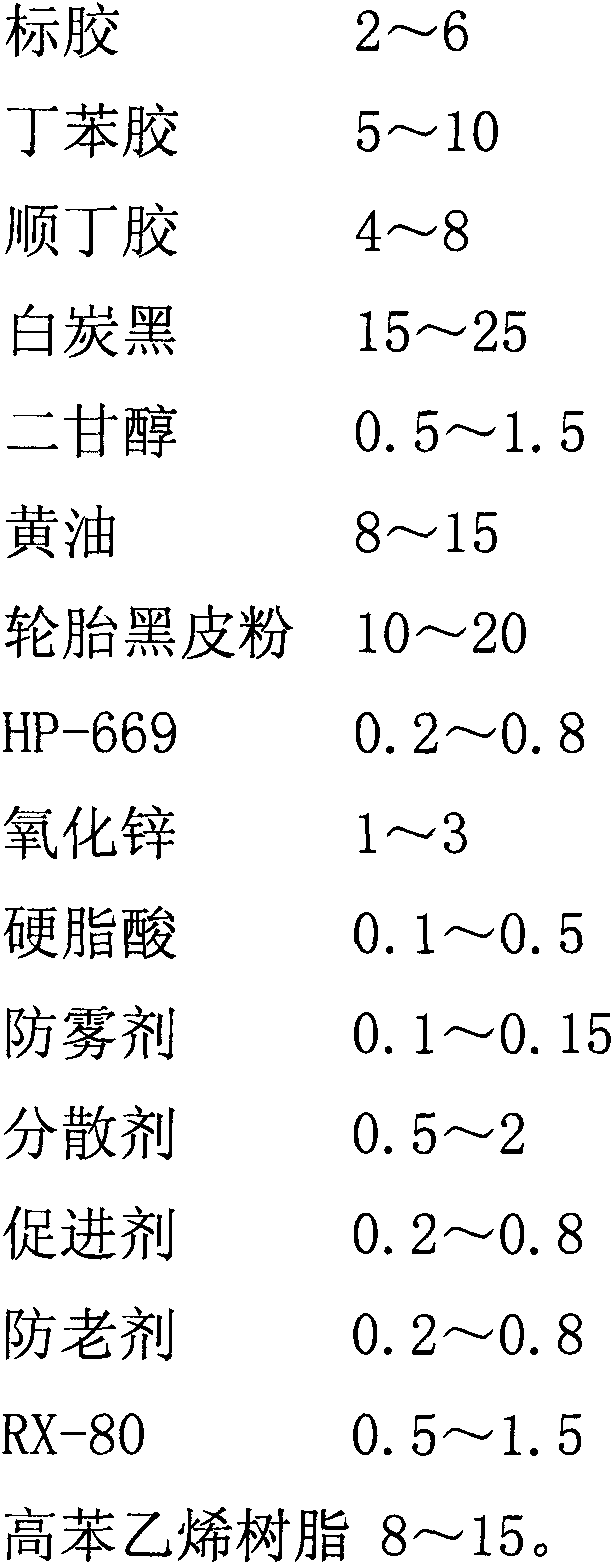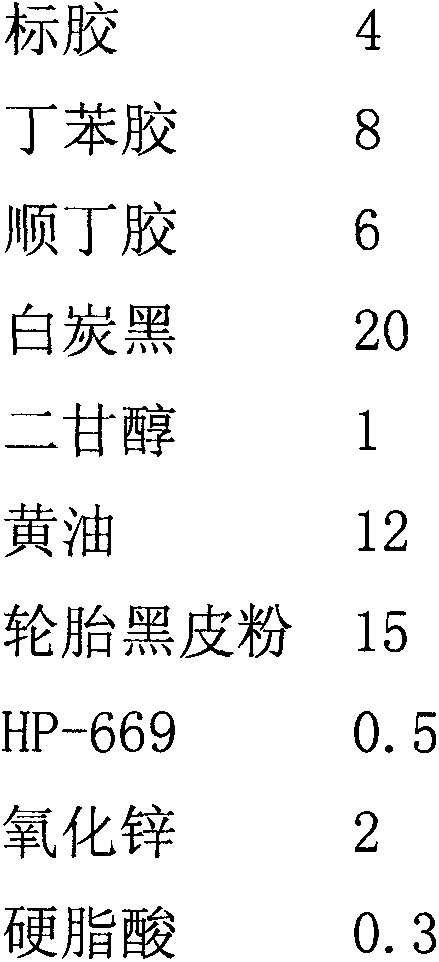Wear-resistant sole material and preparation method thereof
A shoe sole material and accelerator technology, which is applied in the field of shoe sole materials, can solve problems such as increased product burr weight, poor thermal fluidity, and lower yield rate, and achieve the effects of saving costs, reducing burr weight, and improving wear resistance
- Summary
- Abstract
- Description
- Claims
- Application Information
AI Technical Summary
Problems solved by technology
Method used
Image
Examples
Embodiment 1
[0035] 1.1 Composition in parts by weight of wear-resistant sole material
[0036]
[0037] 1.2 Preparation method
[0038] (1) Standard rubber, styrene-butadiene rubber, butadiene rubber, white carbon black, diethylene glycol, butter, tire black skin powder, HP-669, zinc oxide, stearic acid, anti-fog agent, dispersant, accelerator , anti-aging agent, RX-80 and high styrene resin are mixed and stirred evenly according to a certain weight part to obtain a mixture,
[0039] (2) Put the mixture into a banbury mixer, and banbury at 145°C to 150°C for 12 to 15 minutes to obtain a banbury mixture,
[0040] (3) Add the banburying mixture into the screw extruder, and carry out melt blending and granulation at 110°C to 150°C,
[0041] (4) Add the granules to an open mill for mixing, and then mold them to obtain a wear-resistant shoe sole material. 1.3 Properties of wear-resistant sole materials
[0042] 1. Product yield
[0043] The yield of the wear-resistant shoe sole materia...
Embodiment 2
[0049] 2.1 Composition by weight of wear-resistant sole material
[0050]
[0051]
[0052] 2.2 Preparation method
[0053] The preparation method is the same as in Example 1.
[0054] 2.3 Properties of wear-resistant sole materials
[0055] 1. Product yield
[0056] The good product rate of the wear-resistant shoe sole material prepared in Example 2 is above 96%.
[0057] 2. Wear resistance
[0058] After the wear-resistant shoe sole material prepared in Example 2 was placed at a room temperature of 22.0° C. for 24 hours, its wear resistance was tested according to the GB / T3903.2-1994 standard, and the wear scar length was 8.2 mm.
[0059] 3. Rebound performance
[0060] Detected by a vulcanized rubber impact resilience tester, the resilience of the wear-resistant shoe sole material prepared in Example 2 is good.
Embodiment 3
[0062] 3.1 Composition by weight of wear-resistant sole material
[0063]
[0064]
[0065] 3.2 Preparation method
[0066] The preparation method is the same as in Example 1.
[0067] 3.3 Properties of wear-resistant sole materials
[0068] 1. Product yield
[0069] The yield of the wear-resistant shoe sole material prepared in Example 3 is above 98%.
[0070] 2. Wear resistance
[0071] The wear-resistant shoe sole material prepared in Example 3 was placed at a room temperature of 22.0° C. for 24 hours, and then its wear resistance was tested according to the GB / T3903.2-1994 standard, and the wear scar length was 7.8 mm.
[0072] 3. Rebound performance
[0073] Detected by a vulcanized rubber impact rebound performance tester, the wear-resistant shoe sole material prepared in Example 3 has good rebound performance.
PUM
 Login to View More
Login to View More Abstract
Description
Claims
Application Information
 Login to View More
Login to View More - R&D
- Intellectual Property
- Life Sciences
- Materials
- Tech Scout
- Unparalleled Data Quality
- Higher Quality Content
- 60% Fewer Hallucinations
Browse by: Latest US Patents, China's latest patents, Technical Efficacy Thesaurus, Application Domain, Technology Topic, Popular Technical Reports.
© 2025 PatSnap. All rights reserved.Legal|Privacy policy|Modern Slavery Act Transparency Statement|Sitemap|About US| Contact US: help@patsnap.com



